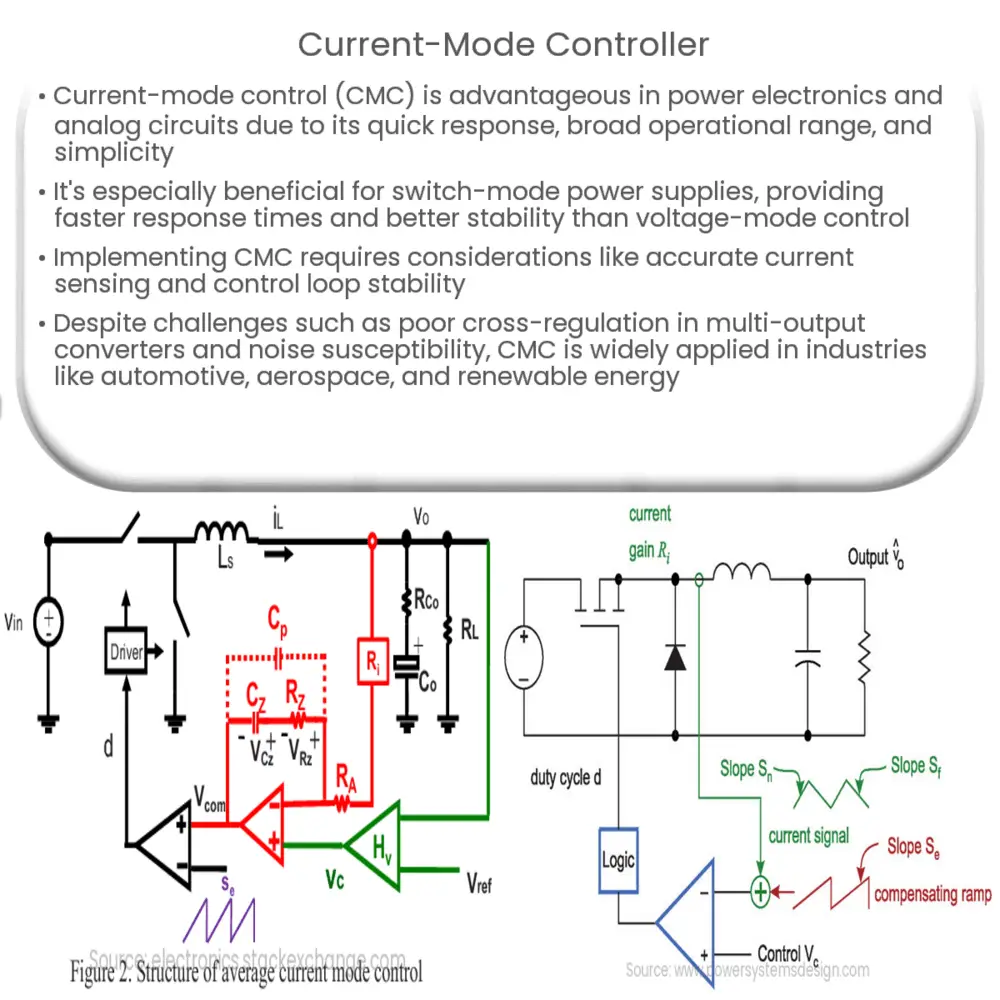A current-mode controller regulates output current in power electronics & analog circuits, offering fast response, wide range, and noise immunity.

Current-Mode Controller: An Overview of Design and Applications
Introduction
Current-mode control (CMC) is a popular control method used in power electronics and analog circuit designs for its advantages in transient response, wide operating range, and simplicity. This article aims to provide an overview of current-mode controllers, their design principles, and applications in various industries. In the first part, we will discuss the fundamentals of CMC and its advantages over other control methods. The second part will delve deeper into the design considerations and challenges in implementing current-mode control in practice.
Current-Mode Control: The Basics
Current-mode control is a technique where the output current of a power converter or an analog circuit is regulated by adjusting the input voltage. The output current is sensed and fed back into the controller, which then adjusts the input voltage to maintain the desired output current. This feedback loop allows for faster response times and better stability compared to voltage-mode control, which relies on adjusting the output voltage directly.
In power electronics, current-mode control is particularly well-suited for switch-mode power supplies (SMPS), where the output current can be regulated by controlling the duty cycle of the switching devices. By modulating the duty cycle, the average input voltage applied to the power stage can be adjusted, thus controlling the output current. This ability to respond quickly to changes in load conditions makes current-mode control an attractive choice for applications where fast transient response and precise regulation are critical.
Advantages of Current-Mode Control
Current-mode control offers several advantages over other control methods, such as voltage-mode control, particularly in power electronics applications. Some of these advantages include:
- Fast transient response: The current feedback loop allows the controller to respond quickly to changes in load conditions, minimizing output voltage deviations and improving the overall transient response.
- Wide operating range: Current-mode controllers can operate over a wide range of input voltages and output currents, making them suitable for applications with variable operating conditions.
- Simple control loop design: The current feedback loop simplifies the design of the control loop, reducing the need for complex compensation networks and simplifying the overall design process.
- Better noise immunity: Current-mode control is less susceptible to noise and disturbances in the input voltage, allowing for more robust operation in noisy environments.
In the next part of this article, we will discuss the design principles and challenges involved in implementing current-mode control, along with some common applications in the industry. Stay tuned to learn more about this versatile control technique and how it can be applied to optimize your power electronics and analog circuit designs.
Design Principles of Current-Mode Control
When designing a current-mode controller, several key factors need to be considered to achieve optimal performance. These factors include:
- Current sensing: Accurate current sensing is essential for effective current-mode control. Various techniques, such as using a current-sense resistor, a current-sense transformer, or a Hall-effect sensor, can be employed depending on the application and desired accuracy. The choice of current sensing method will impact the overall efficiency, cost, and complexity of the controller.
- Control loop stability: Ensuring stability in the current feedback loop is critical to avoid oscillations and maintain desired performance. This often involves the selection of appropriate compensation components, such as capacitors and resistors, to achieve a stable closed-loop system.
- Switching frequency: The switching frequency of the power converter plays a significant role in determining the transient response, efficiency, and size of the overall system. Higher switching frequencies typically result in faster transient response and smaller passive components, but may also increase switching losses and electromagnetic interference (EMI).
- Protection features: Including protection features, such as overcurrent, overvoltage, and thermal protection, can improve the reliability and safety of the current-mode controller and the overall system.
Challenges in Implementing Current-Mode Control
While current-mode control offers numerous benefits, some challenges need to be addressed when implementing this technique in practice. These challenges include:
- Current sharing and cross-regulation: In multi-output converters, current-mode control may result in poor cross-regulation and unequal current sharing among the outputs. This issue can be mitigated by using more sophisticated control techniques, such as average current-mode control or implementing a separate current-loop for each output.
- Right-half-plane zero (RHPZ): In certain power converter topologies, such as boost converters, current-mode control can introduce a right-half-plane zero (RHPZ) in the transfer function, which can lead to stability issues. This challenge can be addressed by carefully designing the compensation network to provide adequate phase margin.
- EMI and noise susceptibility: Current sensing methods, particularly those involving high-frequency switching, can be susceptible to electromagnetic interference (EMI) and noise. Proper shielding and filtering techniques should be employed to minimize the impact of noise on current sensing accuracy and overall controller performance.
Applications of Current-Mode Control
Current-mode control is widely used in a variety of industries and applications, such as:
- Switch-mode power supplies (SMPS) for computers, servers, and telecom equipment
- DC-DC converters for automotive, aerospace, and industrial applications
- Battery chargers and energy storage systems
- LED lighting and electronic ballasts for fluorescent lamps
- Solar and renewable energy conversion systems
In conclusion, current-mode control offers numerous advantages in power electronics and analog circuit design, including fast transient response, wide operating range, and simplicity. By understanding the design principles, addressing the challenges, and leveraging the benefits, engineers can utilize current-mode control to optimize their designs and deliver high-performance, reliable, and efficient solutions for various applications.

